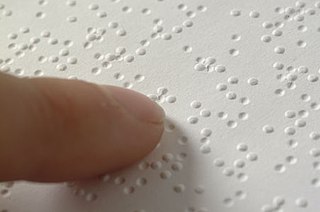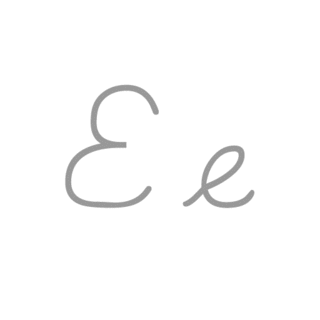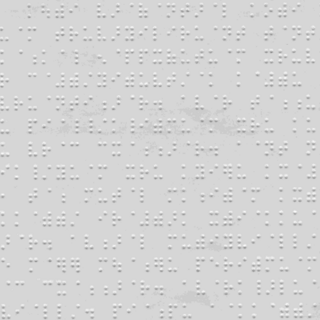
Braille is a tactile writing system used by people who are visually impaired. It is traditionally written with embossed paper. Braille users can read computer screens and other electronic supports using refreshable braille displays. They can write braille with the original slate and stylus or type it on a braille writer, such as a portable braille notetaker or computer that prints with a braille embosser.
A diacritic is a glyph added to a letter or basic glyph. The term derives from the Ancient Greek διακριτικός, from διακρίνω. The word diacritic is primarily a noun, though it is sometimes used as an adjective, whereas diacritical is only an adjective. Some diacritics, such as the acute ( ´ ) and grave ( ` ), are often called accents. Diacritics may appear above or below a letter or in some other position such as within the letter or between two letters.

E, or e, is the fifth letter and the second vowel letter in the modern English alphabet and the ISO basic Latin alphabet. Its name in English is e, plural ees. It is the most commonly used letter in many languages, including Czech, Danish, Dutch, English, French, German, Hungarian, Latin, Latvian, Norwegian, Spanish, and Swedish.

The International Phonetic Alphabet (IPA) is an alphabetic system of phonetic notation based primarily on the Latin script. It was devised by the International Phonetic Association in the late 19th century as a standardized representation of speech sounds in written form. The IPA is used by lexicographers, foreign language students and teachers, linguists, speech–language pathologists, singers, actors, constructed language creators and translators.
Esperanto is written in a Latin-script alphabet of twenty-eight letters, with upper and lower case. This is supplemented by punctuation marks and by various logograms, such as the digits 0–9, currency signs such as $ € ¥ £, and mathematical symbols. The creator of Esperanto, L. L. Zamenhof, declared a principle of "one letter, one sound", though this general guideline is not strictly followed.
The Slovene alphabet is an extension of the Latin script and is used in the Slovene language. The standard language uses a Latin alphabet which is a slight modification of the Croatian Gaj's Latin alphabet, consisting of 25 lower- and upper-case letters:

The modern English alphabet is a Latin alphabet consisting of 26 letters, each having an upper- and lower-case form. It originated around the 7th century from Latin script. Since then, letters have been added or removed to give the current Modern English alphabet of 26 letters with no diacritics, digraphs, and special characters. The word alphabet is a compound of the first two letters of the Greek alphabet, alpha and beta.
A ring diacritic may appear above or below letters. It may be combined with some letters of the extended Latin alphabets in various contexts.

Japanese Braille is the braille script of the Japanese language. It is based on the original braille script, though the connection is tenuous. In Japanese it is known as tenji (点字), literally "dot characters". It transcribes Japanese more or less as it would be written in the hiragana or katakana syllabaries, without any provision for writing kanji.
Polish orthography is the system of writing the Polish language. The language is written using the Polish alphabet, which derives from the Latin alphabet, but includes some additional letters with diacritics. The orthography is mostly phonetic, or rather phonemic—the written letters correspond in a consistent manner to the sounds, or rather the phonemes, of spoken Polish. For detailed information about the system of phonemes, see Polish phonology.
Thai Braille (อักษรเบรลล์) and Lao Braille (ອັກສອນເບຣລລ໌) are the braille alphabets of the Thai language and Lao language. Thai Braille was adapted by Genevieve Caulfield, who knew both English and Japanese Braille. Unlike the print Thai alphabet, which is an abugida, Thai and Lao Braille have full letters rather than diacritics for vowels. However, traces of the abugida remain: Only the consonants are based on the international English and French standard, while the vowels are reassigned and the five vowels transcribed a e i o u are taken from Japanese Braille.

English Braille, also known as Grade 2 Braille, is the braille alphabet used for English. It consists of 250 or so letters (phonograms), numerals, punctuation, formatting marks, contractions, and abbreviations (logograms). Some English Braille letters, such as ⠡ ⟨ch⟩, correspond to more than one letter in print.

Bharati braille, or Bharatiya Braille, is a largely unified braille script for writing the languages of India. When India gained independence, eleven braille scripts were in use, in different parts of the country and for different languages. By 1951, a single national standard had been settled on, Bharati braille, which has since been adopted by Sri Lanka, Nepal, and Bangladesh. There are slight differences in the orthographies for Nepali in India and Nepal, and for Tamil in India and Sri Lanka. There are significant differences in Bengali Braille between India and Bangladesh, with several letters differing. Pakistan has not adopted Bharati braille, so the Urdu Braille of Pakistan is an entirely different alphabet than the Urdu Braille of India, with their commonalities largely due to their common inheritance from English or International Braille. Sinhala Braille largely conforms to other Bharati, but differs significantly toward the end of the alphabet, and is covered in its own article.

The Esperanto language has a dedicated braille alphabet. One Esperanto braille magazine, Aŭroro, has been published since 1920, and another, Esperanta Ligilo, since 1904.
The goal of braille uniformity is to unify the braille alphabets of the world as much as possible, so that literacy in one braille alphabet readily transfers to another. Unification was first achieved by a convention of the International Congress on Work for the Blind in 1878, where it was decided to replace the mutually incompatible national conventions of the time with the French values of the basic Latin alphabet, both for languages that use Latin-based alphabets and, through their Latin equivalents, for languages that use other scripts. However, the unification did not address letters beyond these 26, leaving French and German Braille partially incompatible and as braille spread to new languages with new needs, national conventions again became disparate. A second round of unification was undertaken under the auspices of UNESCO in 1951, setting the foundation for international braille usage today.
Albanian Braille is the braille alphabet for writing the Albanian language. Like other braille alphabets for languages written in the Latin script, the simple Latin letters are all assigned values based on international braille.

The braille alphabet used to write Hungarian is based on the international norm for the 26 basic letters of the Latin script. However, the letters for q and z have been replaced, to increase the symmetry of the accented letters of the Hungarian alphabet, which are largely innovative to Hungarian braille.
Slovak Braille is the braille alphabet of the Slovak language. Like braille for other languages using the Latin script, Slovak Braille assigns the 25 basic Latin letters the same as Louis Braille's original assignments for French Braille.
IPA Braille is the modern standard Braille encoding of the International Phonetic Alphabet (IPA), as recognized by the International Council on English Braille.
Cambodian or Khmer Braille is the braille alphabet of the Khmer language of Cambodia.









